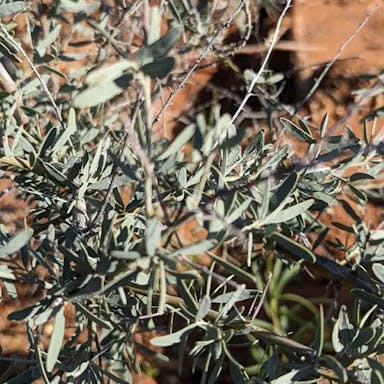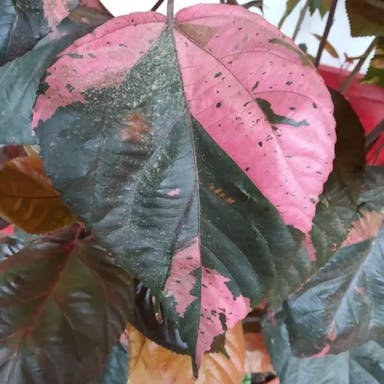The initial statement discusses Flamebush's scientific name Adenanthos cuneatus, native region of Western Australia and taxonomic family Proteaceae. The next portion reviews physical attributes: wedge-shaped leaves per Latin derivation of name. Subsequently, vivid red blossoms resembling fire lead to common appellation. Nectar draws winged creatures. Statistics follow pertaining to maximum growth in height and width classifying it suitable for landscaping. Preference for drainage and sunlight exposure noted. Continuing, solely aesthetic purpose outlined lacking edible yield. Several variations exist through selective propagation differentiated by subtle distinctions in hue and leaf contours. Striking visual qualities and minimal care explain popularity among horticulturists. Limit is 200 terms.
Flamebush
- Scientific name
- Adenanthos cuneatus
Basic Information
- Proteaceae Family Adenanthos Genus Flamebush Species
- Proteaceae > Adenanthos > Adenanthos cuneatus
- 83%
- The Completeness of This Encyclopedia
Please help us complete the encyclopedia, Terrarium is a encyclopedia service to be completed with everyone in the world. Currently, this page is 83% complete. For more information on how to contribute, please click here.
- Shrub
- Height
- 30cm ~ 100cm
- Flower Color
- Leaf Color
- Anthesis
- spring,summer
- Sunlight Exposure
Full Sun Long hours of sunlight from morning to afternoon Partial Shade A location in the shade of a tree or where either the morning or afternoon is shaded Full Shade A place where there is no direct sunlight
- Full Sun
- Hardiness Zones
This is an indicator to know to which zone each plant can winter. Knowing the zone of each plant gives you an idea of the cold temperature resistance when grown in the ground without a roof. 2: -42.7 to -40.0 3: -39.9 to -34.4 4: -34.3 to -28.9 5: -28.8 to -23.3 6: -23.2 to -17.8 7: -17.7 to -12.2 8: -12.1 to -6.7 9: -6.6 to -1.1 10: -1.0 to 4.4 11: 4.5 to 10.0
- 9
- Cold resistance
- Poor
- Heat resistance
- Good
- Habitat of origin
- Australia
- Growth Rate
- Normal
What is Flamebush (Adenanthos cuneatus)?
What is Flamebush (Adenanthos cuneatus)
Flower meaning
The oddball floral implication broadly utilized in America for the botanical Flamebush is as pursues: - Enthusiasm - Want - Love - Vigor One run of the mill model is
Calendar of Flamebush (Adenanthos cuneatus)
Calendar
Spring and summer Flamebush bloom in United States. Best blooming happens late spring and early summer. Few weeks it blooms period. Two to four week takes Flamebush flower for full blooming. For long flowering, ensure sunlight, water, nutrients properly. Pruning dead flowers help new flower blooming. Also keep soil moisture level constant, it help prolong flowering time.
How to grow Flamebush (Adenanthos cuneatus)
Watering
The Flamebush plant requires adjusted sprinkling frequency counting on seasonal differences. In the developing time in spring and summer, moisten the plant every 7-10 days, ensuring the soil is damp but not inundated. In winter, decrease sprinkling to every 14-21 days as the plant is inactive and needs less aqua. Check earth dampness by placing a digit into the soil up to 2 inches profound; if it feels parched, it's opportunity to sprinkle. Douse the Flamebush plant completely, permitting excess aqua to empty out of the pot to avert root decay. Modify sprinkling recurrence in view of ecological conditions to keep up ideal plant wellbeing.
Soil and Fertilizer
Flamebush thrives in well-draining soil with a pH level between 6.0 and 7.0. It prefers sandy or loamy soil that is rich in organic matter. Use fertilizer with a ratio of 10-10-10 or similar, follow the instructions for application rates. Avoid too much fertilizer, as it can harm. Often check the soil quality to ensure it remains well-draining and amend if needed. Watch the plant's growth and change fertilization accordingly.Add balanced slow-release fertilizer in early spring before new growth appears to Flamebush. Put fertilizer again in mid-summer to support blooming.
Sunlight and Place
The shrub needs full exposure to sunshine, requiring minimum six hours of direct light every day. It has superior tolerance for high temperature, so suitable for hot zones. This plant can stand cold to around 20°F (-6.7°C). It is prudent to shield it from frost over winter by repositioning inside or covering. Ideal temperature range is 65-85°F (18-29°C). Good air flow around the plant helps prevent disease. More watering over summer fights heat stress. Less watering in winter avoids root rot. Bright sunlight brings out the most brilliant colors in the foliage.
Advanced Information of Flamebush (Adenanthos cuneatus)
Pruning
Flamebush needs pruning often. This keeps it looking nice, helps it grow, and makes it flower more. Dead parts should be cut off. Tools should be clean so diseases don't spread. Prune Flamebush at the end of winter or start of spring before new growth starts. Make clean cuts just above a bud or branch. Get rid of cut parts so diseases don't spread. After pruning, check for pests or diseases. Fix any problems fast.
Planting and Harvest
Flamebush thrives best when potted rather than planted in-ground due to its preference for well-draining soil and controlled environment. Mist Flamebush every day, sustain it in a sunny spot on the window, and water the Flamebush when the top inch of soil feels dry to touch. To pot Flamebush, choose a container with drainage holes, fill the tropical plant in a mix of potting soil and sand, and place the tropical plant at the same depth as it was in a previous container. When repotting, pick out a slightly larger pot, gently remove the tropical plant from its current container, and put it in the new one with fresh soil.
Propagation
Flamebush can propagate by seeds, cuttings, and division. Seeds plant well-draining earth, keep wet, place warm, sunny spot. Cuttings take healthy stems, dip hormone, plant soilless mix. Division separate smaller sections roots attached, replant individual pots. Maximize propagation success, use combination methods. Harvest seeds mature dry, take cuttings morning well-hydrated plants.
Pests and Diseases
Flamebush is susceptible to pests such as spider mites, aphids, and scale insects, which can cause damage by sucking sap from the plant. These pests can lead to yellowing of leaves, stunted growth, and wilting of the plant. To prevent diseases, ensure good air flow around the plant and avoid overhead watering. For root rot, proper drainage and avoiding overwatering are essential. Regularly checking the plant's condition can help detect and treat diseases early. To prevent infestations, regular inspection of the plant is crucial for early signs of pests. Additionally, maintaining good plant health by removing any dead or infected plant material can help reduce the risk of pest infestations. Flamebush is also prone to diseases like powdery mildew and root rot. Powdery mildew appears as a white powdery substance on the leaves, while root rot causes the roots to decay, leading to wilting and eventual death of the plant.
Habitat of Flamebush (Adenanthos cuneatus)
Habitat
Toxicity of Flamebush (Adenanthos cuneatus)
Health Benefits
- edible
- Inedible
- Toxic
- No toxicity
NO DATA
Toxic for dogs and cats
NO DATA
Q&A of Flamebush (Adenanthos cuneatus)
- choice
Place adults and children must have sound green flora bereft of stains or disfiguration. Appear for secure stems and circumvent those with signals of flagging. Check for precise flourishing prerequisites for every assortment to assure booming farming. When singling Flamebush generations, single full, tight generations bereft of any evident impairment. Confirm the generations are not run out and approach from a creditable wellspring. Distinct Flamebush varieties embrace 'Scarlet Flare' with energetic red posies, 'Gilded Glow' with blazon garlands, and 'Crimson Inferno' recognized for its profound red foliage. Every assortment proffers unique attributes, so single grounded on your inclination for posy tone or foliage.






